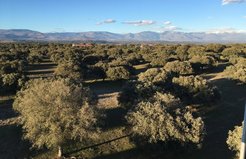Natural ecosystems need balanced nitrogen and phosphorus levels for most efficient use of water
The efficiency of plants to use water and take up carbon dioxide for growth critically depends on the availability of nitrogen, phosphorus and their balance in the ecosystem. In a recent study, researchers of the Max Planck Institute for Biogeochemistry and their Spanish partners analyzed how plants and their environment respond to the addition of these nutrients. They found for a semi-arid savanna ecosystem that the excess of the single nutrient nitrogen increases plant growth, but also leads to higher water usage. Only when both nitrogen and phosphorus were added simultaneously, the increased carbon uptake and plant growth occurs at the normal consumption of water.

Nitrogen and phosphorus are the two most important nutrients for the growth of plants. Human activities add considerable amounts of nitrogen to the environment, through agricultural fertilization, but also as a result of fossil fuel combustion. Plants and ecosystems therefore receive additional anthropogenic nitrogen input, but no additional phosphorus. This imbalance between nutrients is expected to affect plant growth and productivity.
In a large-scale nutrient manipulation experiment researchers of the Max-Planck Institute for Biogeochemistry (MP-BGC) in Jena, Germany, and their Spanish partners analyzed how a natural ecosystem responds to imbalanced nitrogen and phosphorus availability. In a semi-arid savanna located in Majadas de Tietar, in the center of the Iberian Peninsula, two neighboring areas of about 20 ha were fertilized with either nitrogen only - simulating the nutrient imbalance - or simultaneously with balanced nitrogen and phosphorus input. A third area was not fertilized and served as a control. The response of the ecosystem was continuously monitored with a variety of cutting-edge technologies regarding environmental and physiological parameters of the fertilized herbaceous plants and trees as well as the soils underneath.
Not surprisingly, during 5 years after the fertilization the nitrogen-only treatment showed an increase in vegetation growth compared to the control. However, this was accompanied by a strongly increased water consumption of the ecosystem. This water loss was found as both an increased evapotranspiration rate and a reduced soil moisture content of the area fertilized with nitrogen only. Contrary, when both nitrogen and phosphorus nutrients were added in the balanced treatment, water usage was not increased compared to the control, despite the increased vegetation growth, which was similar to the nitrogen-only treatment. “We conclude that the balanced availability of nutrients leads to a more efficient use of water” says Dr. Mirco Migliavacca, group leader at MPI-BGC and senior author of the study.
Similar results have been obtained earlier and on smaller scales by other researchers, who analysed leaves from individual plants or even whole plants or plant communities in mesocosm experiments. “But this is the first time that increased water loss due to nutrient imbalance could be demonstrated in a whole natural ecosystem, effectively in real life” says Dr. Tarek El-Madany, scientist at MPI-BGC and first author of the study.
The additional water loss can be explained by two common hypotheses. Firstly, nitrogen and phosphorus have different effects on the opening of stomata, the plants’ tiny pores that allow uptake of carbon dioxide from the atmosphere but at the same time lead to water loss by transpiration. Secondly, it is well known that plants try to balance the nutrient uptake by dissolving them from soils through root exudates. The latter is supported by the experimental finding that root biomass was increased and its morphology altered in the nitrogen-only treatment. Interestingly, trees in the experimental site did not change their carbon uptake and water use when fertilized differently for 5 years. This can be explained by the fact that the herbaceous layer with its shallow root system quickly responds to fertilization in the uppermost soil layer, while the deeper-rooted trees experienced no nutrient changes.
The publication demonstrates the importance of raising nutrient studies to the ecosystem level. Its key results may have profound implications in particular for regions where the changing climate leads to increased temperatures and simultaneous depletion of water. “When water is scarce, e.g. in semi-arid regions, the limitations of phosphorus compared to nitrogen can exacerbate the water losses of the ecosystem because plants use water less efficiently” concludes Migliavacca.












